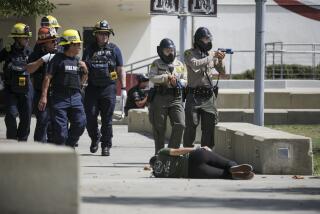Senate OKs Bill Calling for School AIDS Film
SACRAMENTO — Legislation requiring that students in junior and senior high school receive instruction in the causes and prevention of AIDS overwhelmingly passed the Senate on Monday, despite the concern of one lawmaker that homosexuals might use the classroom as a “forum.”
The bill by Sen. Gary K. Hart (D-Santa Barbara) would require state Supt. of Public Instruction Bill Honig to select by next fall a videotape or film that stresses abstinence from sexual activity as the most effective method of preventing acquired immune deficiency syndrome.
On a bipartisan 32-4 vote, the measure went to the Assembly where an omnibus bill is taking shape to incorporate many of the wide-ranging AIDS recommendations issued in October by U.S. Surgeon General C. Everett Koop.
Assistants to Assemblyman Art Agnos (D-San Francisco), author of legislation to outlaw employment discrimination against AIDS victims, said the legislation would be the first comprehensive state plan of its kind in the nation.
Would Require Videotape
Koop, who recommends that AIDS education start as early as possible in the schools, is scheduled to speak to a joint meeting of the Senate and Assembly on Thursday.
The Hart legislation would require every California public school to show to students in grades 7 through 12 a videotape dealing with the causes of AIDS and methods of preventing the fatal illness. Parents who objected could exclude their children from the instruction.
The Los Angeles City Unified School District last autumn became one of the first in the nation to require AIDS instruction in grades 7-12. The program stresses sexual abstinence but encourages the use of condoms and the avoidance of “risky” sexual practices.
Acquired immune deficiency syndrome, for which no cure has been found, can be transmitted by sexual activity, blood transfusions and by the use of contaminated hypodermic needles, a common practice among intravenous drug users.
While only a few years ago AIDS was regarded as almost exclusively a disease of homosexual men and hemophiliacs, it has spread to include heterosexuals, newborn infants and drug users in epidemic proportions. In California during the next four years, an estimated 34,000 people will die of AIDS.
Hart told the Senate that he intends the video to serve as “an icebreaker to begin the process of starting discussion of this awful disease” in the classroom. He cited figures he said show that “about half of our young people in high school are sexually active.”
Sen. Russell’s Concern
However, Sen. Newton R. Russell (R-Glendale), who successfully pushed for an amendment to the bill last week making the teaching of abstinence “the primary” way of preventing AIDS, voiced concern that classroom discussions could include homosexual speakers who might use the occasion “as a forum by those who are not neutral on the issue.”
Russell said such speakers might discuss “their views on AIDS or how they protect themselves.” He conceded, however, that under the Constitution they probably could not be banned from a classroom discussion. He voted for the bill.
A former teacher, Hart responded that he trusts that local school authorities, who have offered sex education in the curriculum for years, would use discretion and good judgment in selecting possible outside speakers for AIDS classes.
To coincide with Koop’s appearance before the Legislature, Agnos put the finishing touches on his estimated $1.2-million landmark legislation that will incorporate the findings and recommendations on AIDS of the surgeon general.
A centerpiece would be creation of a 21-member commission that would report to the governor and Legislature on, among other things, the status of current and emerging issues of AIDS health care, research and prevention efforts. It also would study legal and ethical questions involving testing for AIDS.
Impact Reports
The bill also calls for every state government agency that would have any dealing with AIDS issues to report to the commission on the impact of the AIDS “crisis” on each entity and the agency’s ability to respond to it.
Additionally, as a condition to receiving a diploma from high school, each California public school student would receive instruction in the causes and prevention of AIDs and other sexually transmitted diseases.
Also, no school could prohibit a youngster from attending school on the basis of AIDS or an AIDS-related condition, except where school officials found the student’s attendance would be “inimical to the child or other students.” The “inimical” finding could occur only after a conference with the child’s parents, physician and a public health officer.
More to Read
Sign up for Essential California
The most important California stories and recommendations in your inbox every morning.
You may occasionally receive promotional content from the Los Angeles Times.










